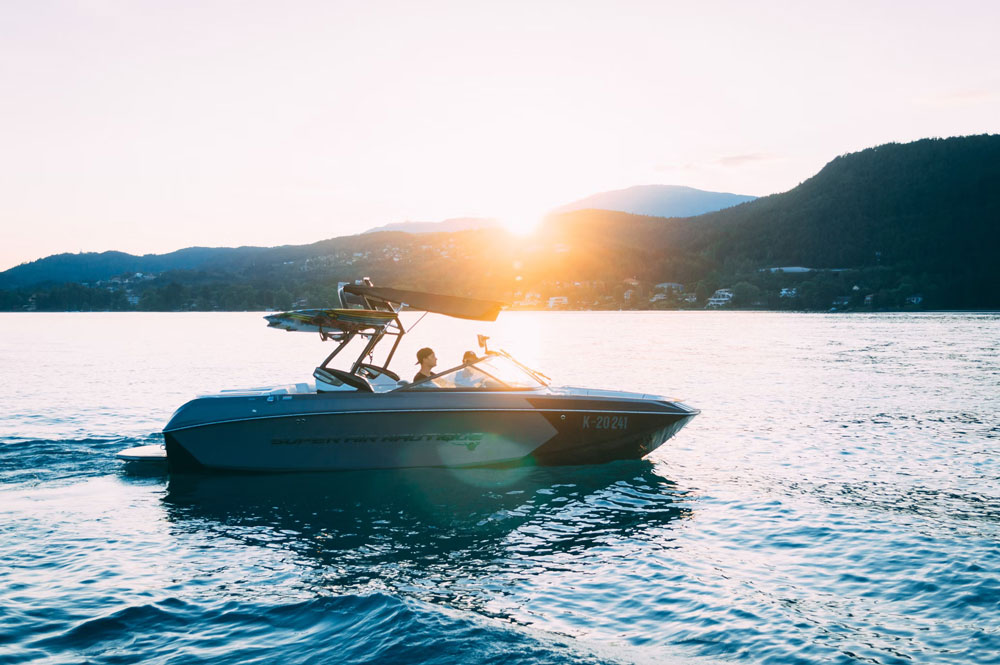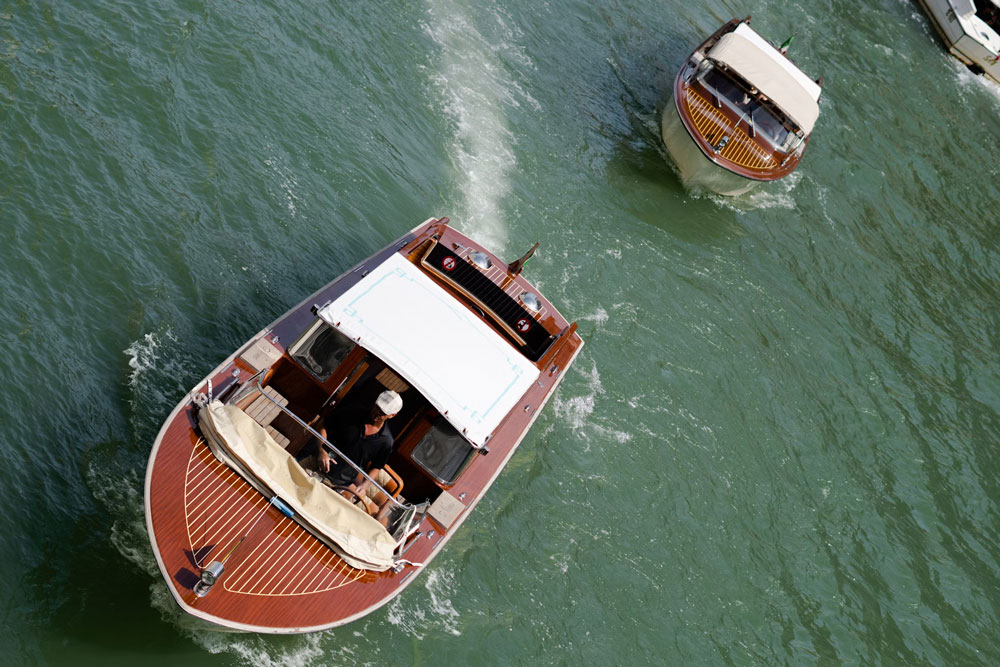
Glastron MX175 and SX175 Bowriders Review
The Glastron MX175 and SX175 bowriders have an excellent finish, attractive prices, and slick marketing. But I have to admit to being somewhat disappointed with the fit-out of the Glastron MX175 and SX175. These two boats were short on the frills one normally associates with turnkey, mass-produced American-made bowriders. Clearly, the boats are built to a price.
But once you take these Glastron bowriders out on the water, they tell a different story than intended. Performance-wise, these are among the very best entry-level trailerboats I have driven. What these simple boats lack in superfluities is that they are more than make up for with substance. And I am not alone in forming that opinion.
My greatest critic, my partner, who usually flashes looks of disdain while crashing over the oat wake, gave these boats the thumbs up. She even claimed the little Glastron 17-footer was smoother riding than my 19-foot sportsfisher. And it can't even claim to be built to a price.
We weren't fishing miles out to sea, mind you, but for the bays, rivers and harbours, the Glastrons are right at home. Performance, I have always believed, is not a factor of price but merely design. Indeed, the Glastron 175s prove as much.
The difference between the Glastron MX175 and Glastron SX175 is the add-ons. Should you need them, buy the SX175, which is the exact same hull and motor packed with an extra $4000 worth of goodies. Glastron says the SX175 is the world's best-selling 17ft bowrider. Sans extras, the Glastron MX175 is an even better value.
Glastron's Comeback and Cutting-Edge Boatbuilding
You may know Glastron from when it was imported here some decades ago. US boatbuilding giant Genmar, parent company of household trailer boat brands such as Wellcraft and Aquasport, pitches the badge at budget-constrained family boaters.
For one reason or another, there's been an awful lot of water under the hull since we last saw the 50-year-old boats boogying Down Under. In the intervening years, Glastron quietly evolved into the world's fastest-growing boatbuilder.
The reason for Glastron's growth is as much about production efficiencies—namely a new closed-mould boatbuilding process called VEC (see story hereabouts)—as the boats' rise in popularity. Whereas most boats are made in a female mould, the VEC process uses a closed mould for perfectly fair hulls inside and out.
Glastron also uses computer-aided design tools, robotic milling machines, computer-controlled cutters and production processes employed by the automotive industry. The end result is a boat that's made with significantly less wastage, no wood whatsoever, and is lighter than old, traditionally made boats.
Such is Glastron's confidence in this new boatbuilding method that every VEC boat is backed by a lifetime limited warranty on the hull deck, stringers, and transom. Non-structural components have a two-year warranty. According to the spin doctors, VEC technology is already paying dividends for boat buyers. Pre-loved VEC hulls command higher resale values than conventional hulls, says Glastron, which now boasts the largest, technologically advanced fibreglass boat production centre in the world.
To these things, Glastron adds that it has a reputation for top-performing boats, which was certainly the case from where I sat. However, US buyers are offered further incentives through pay-by-month financing deals, 12-month free servicing, and a 24-hour telephone assistance line with everything from weather forecasts to details about where the nearest on-water fuel bowser is. These are the add-ons: the frills and trimmings for Glastron.
Is the Glastron 175 Worth the Aussie Price Tag?

In America, Glastron boats are nothing if not accessible. The turnkey rigs are pitched as entry-level, everyman family trailer boats. Drive-away deals on the MX175 start at—wait for it—$US10,988.
Sadly, Aussie boaters are disadvantaged by their distance from the US. At the exchange rate of $0.70 AUD, the MX175 costs about $14,300. Add $4000 for freight, five per cent for duty, 10 per cent GST, and the dealer margin and the MX175 comes in at our entry-level price of $27,999 on an American-made trailer. The Glastron MX175 was powered by a four-cylinder MerCruiser 3.0L petrol inboard motor. The same combination but with some extras badged as the SX175 sells for $31,950 drive-away. Part of the mission was to determine whether the extras represent money well spent.
On the safety front, the Glastrons rate highly for no other reason than the fact that they're foam-filled. Yet despite having a sharp 21° deadrise, which, along with the foam, helps explain the smooth ride, the boats are remarkably stable. The Glastron 175 hull and the SX195 and GX205 I also drove on the day all display high freeboard in the bow and transom. I managed to put some spray on the windscreen of the MX175 when I dropped the little boat in a hole, but otherwise, it was very dry and loathe to ship water.
Cockpit depth in the Glastron 175s is 1.09m, the beam is a handy 2.24m, and maximum load capacity is 522kg. Yet for all this, the two boats weigh between 920kg and 930kg, plus trailer, which isn't a lot.
Compared to its greatest rival, Bayliner's 175 - which sells for about $US9995 in America - the Glastron is 70kg heavier, 11cm wider, but 12cm shorter. Significantly, the Glastron carries almost one-third more fuel, or 87lt, compared to 68lt. The local dealer added some extras to the MX175 to make it more Australian-friendly. These included two-rod holders, a GME marine stereo, a canopy and a carpet. Both models were fitted with a cross-bollard in the bow. The boats don't have anchor lockers.
175 SX vs MXS
Both Glastron 175 bowriders have full fibreglass liners, integrated swim platforms and short pull-down swim ladders. There are ski tow eyes, navigation and anchor lights, deck fuel fillers and aft and amidships cleats. The Glastron SX175 has sportier graphics and a different windscreen with an extended rear frame, creating a false elliptical window. This windscreen is supported by stainless-steel struts, not the alloy-and-plastic struts on the MX175.
Both windscreens have opening centre panes with ineffective straps to keep them open. If you were to take off with the windscreen open, which you are reminded not to do by way of a printed warning, the retaining strap and press stud won't stop the opening pane slamming shut, perhaps on little fingers. The big difference between the MX175 and SX175 is the seating layout. The MX has two small upholstered side cushions in the bow and a moulded, non-skid centre step leading to a non-skid foredeck for jumping ashore. The SX175 has a centre cushion and no non-skid anywhere.
Storage isn't a highlight of the MX175. Under its bow seats and aft lounge are five small open recesses with moulded retaining lips for stowing, one assumes, lifejackets if not towels or personals.
To better retain any of these items on the MX175, this writer would add small elastic nets across the open stowage areas, elastic bungee straps, or perhaps attend a local Tupperware party and buy some containers from Mavis that slot into the spaces.
Storage and Seating Comparisons
According to the brochure, the passenger and helm footwells are suggested storage on the MX175. But the best storage on both boats is their large subfloor ski/kneeboard lockers, whose loose-fitting lids should be hinged in my opinion.
There is also a surplus of space around the inboard motors, though one would need to add storage nets to retain gear here. The MX's co-pilot dash has a small moulded recess for holding things, but there is no means of keeping them there. In other words, if you place a mobile phone or wallet here, it could easily fly overboard in a tight turn.
Still, on the storage front, this boat tester can't help but wonder about the actual cost of adding side pockets to the MX175. There is certainly room in the hull sides for them, and I like side pockets in boats.
The SX175's storage is much better, with partially lined recesses under the bow seating, a lined centre storage compartment up front that could take an anchor or be used as an icebox, a glovebox (hooray) for personals, and side pockets (hip-hip-hooray).
Whereas the Glastron MX175 had a rear lounge that could accommodate three people, the SX175's standard seating arrangement included back-to-back helm seats that convert to sunbeds and rear seats either side of an engine box.
All seats on both models have plastic grab handles nearby, though the rear passengers on the SX175 will have to share them with those sitting on the back of the back-to-back seats.
But my biggest problem is the engine box on the SX175. Moulded as it was from polypropylene, it was just plain awful. Not only did it look bad, but the seating and engine-box combination promoted engine noise to such an extent that flat-out running is migraine-making material.
Glastron 175 Layout
Also, on the SX175, there wasn't much room between the aft-facing seats and the rearmost seats. Adults will be forced to play footsie. So, while I am an advocate of back-to-back seats, they swallow up too much room on this 17-footer.
The solution to these problems on the SX175 is to order the boat with the optional sports seating kit, comprising bucket seats, an aft bench seat, and a sun lounge over the engine. As a bonus, you will get additional storage, including, I think, an icebox under the lounge.
The base model Glastron MX175 had two rather excellent fully adjustable helm seats that slide, swivel and lock in position. The padded seat bases are quite small, but their Springfield mechanisms are great.
Conversely, the seats (which include tiny plastic storage pockets) have backrests that fold forward. So, if passengers in the rear were to grab the seat backs for support when getting off the plane, they might find themselves inadvertently lunging forward.
Interestingly, the back-to-back helm seats on the SX were lower than the pedestal-mounted seats on the MX. While the driving position was perfect on the SX, it was too high on the MX. I had to slump to see under the canopy and through the windscreen, and my partner had her hat blown off her noggin.
The answer is to have the dealer cut 5-10cm off the pedestal tubes to lower the seating height. But with its rear lounge providing some sound insulation—not to mention the full-width sun pad—and more cockpit space than the SX, the seating on the MX is better. And there is no plastic engine hatch that looks ready to melt.
Even considering the lack of side pockets and personal storage, the MX seemed to work better. It would be even further ahead if the seats were lower, but that—as I said—shouldn't be hard to fix.
Crawling around, I noticed lots of foam floatation blown into various voids of these boats, accessible wiring from the battery in the engine bay to the dash, and access to the fuel tank via the engine bay. The VEC boatbuilding system means the engine compartment is nice and smooth, and gas struts assist with lifting the bonnet on the MX175. The plastic lid on the SX175 hinges forward.
While neither boat had an adjustable steering wheel, the dash panels were different. The SX had a brow and a funkier spread of Faria gauges. But even the MX175 had volts, fuel, trim, oil and temp gauges, plus speedo and tacho. And in a way, it was nice to see just two dual-function rocker switches: blower/bilge and nav/anchor. Tilt steering was optional on both boats.
Handling and Performance
The niggling things counted for a lot less once I drove the 175 hulls. My notes read: great drive, predictable, fun, driving pleasure, idiot-proof, sporty handling, a real surprise, and last but not least, blown away by the ride.
Elsewhere, I penned the words "great holeshot". This can be interpreted as an excellent power transfer from a modest four-pot 135hp MerCruiser petrol inboard motor to a clever hull. For some reason, there was a terrible vibration on the Glastron MX175 in 2000. Incredibly, at those revs and 6.6kt (12.5km/h) on the GPS, the boat is planning. With full leg-in trim, the boat holds a handy, level low-speed plane at 2500rpm and 12.4kt (23.5km/h). By which stage the aforesaid vibration disappeared.
The perfect cruise on the MX175 was recorded at 3000rpm and 20kt (38km/h) with nominal trim. Handy midrange 23-24kt (43-46km/h) cruising comes in at 3500rpm; quiet, smooth, fast cruising can be had at 27kt (51.3km/h) and 4000rpm, with the leg trimmed up. Even at 4500rpm with the leg up, the boat seemed predictable but loads of fun at 32kt (61km/h). Flat out (5000-5200rpm), the boat got up and boogied, doing 35.3-36.4kt (67-69km/h) depending on the wind and tide.
The SX175 was about one knot slower at similar rev ranges. The best I could get out of the rig downwind was 35.2kt (66.8km/h). As you are seated lower than the MX175, the ride is less windy and vision isn't impeded by the windscreen framework.
But that engine box and the noise at top revs weren't acceptable on the SX175. There was some vibration in the windscreen. That rattle and the roaring motor were at odds with all the effort that has gone into making such wonderful, smooth and otherwise quiet foam-filled hulls. A quiet achiever, the Glastron SX175 is a little gem. Throw an esky and a soft grab bag with towels aboard, and you're set for a comfortable day afloat, irrespective of the wake, waves and wind.
The MX175 is the plain tomato-and-oregano pizza, the trusty margarita, popped out of the oven and delivered at the right price. It proves that sometimes the best things in life are the simple, affordable ones.
Highs
- Excellent ride and stability
- A real pleasure to drive
- Good value for money
Lows
- Fitout is a little disappointing
- Storage is not a high point on Glastron MX
- SX has an awful engine box
Glastron MX175 and SX175 Bowrider Specs
Glastron 175 Price: Ranges between $45,000 and $60,000 AUD brand new (price as tested)
Priced From: $31,950 with 3.0L MerCruiser petrol inboard engine and EZ Loader trailer
Options Fitted: Dealer-added marine stereo, carpet, bollard, rod holders
Priced from: As above
General
Material: GRP w/ foam flotation and foam-filled chambers
Length (overall): 5.21m
Beam: 2.24m
Deadrise: 21°
Rec/max hp: 135/optional 4.3lt 190hp for SX175
Weight: 919kg/930kg boat and motor only
Capacities
Fuel: 87lt
Water: n/a
Passengers: Six adults/522kg load
Accommodation: n/a
Engine
Make/Model: MerCruiser 3.0L
Type: Four-cylinder, four-stroke petrol inboard motor
Rated hp: 135 @ 4400-4800rpm
Displacement: 3.0lt
Weight: About 192kg dry
Drive (make/ratio): Alpha 1/2.0:1
Props: Standard alloy
Supplied by Webbe Marine Sutherland.
Ready to Set Sail?
Find your dream boat online at Only Boats! We have great deals on boats for sale including used boats and new boats. You can also check out our used boat buying guide.
If you're upgrading or planning to sell your boat, why not explore our expert guide on improving boat resale value? If you're planning to attend a boat show soon, we've also put together a detailed boat show buying guide that's perfect for first-time buyers.
Smooth sailing starts with the right boat. We’re here to help you find it!
This article was written by David Lockwood, and photos provided by John Ford and previously appeared at TradeaBoat.com.au, now powered by Only Boats.
Getting boat finance sorted shouldn't be the hard part of boat ownership. Credit One has helped thousands of Australians get on the water, earning a reputation as Australia's best-reviewed finance broker with 3,000+ glowing Google reviews to show for it. See what customers have experienced by reading their Credit One reviews, or use the loan repayment calculator to work through your options.
